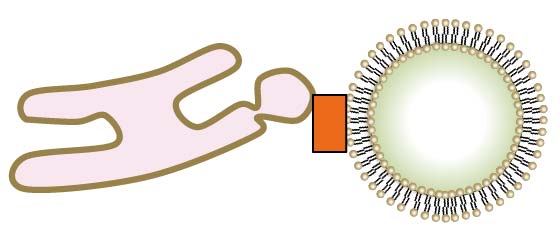Detail Information of Protein
This page represents the latest version, and you may click to view the original version: Version 1.0
Basic Information:
| Symbol | RAB7A |
| Synonyms | RAB7 |
| Protein Name | Ras-related protein Rab-7a (EC 3.6.5.2) |
| Species | Human |
| Entrez ID | 7879 |
| Uniprot ID | P51149 |
| Membrane Contact Site |
ER-Endosome; Endosome-ER

|
| Location (from literature) | Endosome |
| Cell line/Tissue | HEK293 cells; COS-7 cells; U2-OS cells; MelJuSo cells; HeLa cells; hTERT-RPE1 cells; HL60 cells |
| Experimental Method | Low throughput experimental methods |
| Protein Sequence | |
| More related results |
Complex Information:
| Complex ID | Subunit of complex | Subcellular location | Species | More |
| CMCS00006 | ZFYVE27; FYCO1; KIF5B; RAB7A; PI(3)P | ER-Endosome; Endosome-ER | Human | more | CMCS00018 | PDZD8; RAB7A | ER-Endosome; Endosome-ER | Human | more | CMCS00020 | ANO10; RAB7A | ER-Endosome; Endosome-ER | Human | more | CMCS00027 | VAPB; VAPA; OSBPL1A; RAB7A; RILP | ER-Endosome; Endosome-ER | Human | more | CMCS00183 | PDZD8; RAB7A; ZFYVE27 | ER-Endosome; Endosome-ER | Human | more |
Expression Overview of RAB7A:
Homology Information of RAB7A:
| Uniprot ID | P51149 |
| EggNOG | KOG0394 |
| HOGENOM | / |
| OrthoDB | 586759at2759 |
| TreeFam | TF105605 |
| GeneTree | ENSGT00940000155864 |
References:
| Pubmed ID | 32620747 |
| DOI | 10.1038/s41467-020-17016-8 |
| Description | We identify endosomal transport as a major functional cluster of TMEM16K in proximity biotinylation proteomics analyses.TMEM16K forms contact sites with endosomes, reconstituting split-GFP with the small GTPase RAB7. |
| Description of experimental evidence | The protein was validated by microscopy, immunofluorescence, PLA, BioID, mass spectrometry and statistical analysis in HEK293 cells, COS-7 cells and U2-OS cells, and TMEM16K-containing ER-endosome contact sites represent clinically relevant platforms for regulating endosomal sorting. |
| More related results |
| Pubmed ID | 31636202 |
| DOI | 10.1073/pnas.1913509116 |
| Description | PDZD8 mediates a Rab7-dependent interaction of the ER with late endosomes and lysosomes. |
| Description of experimental evidence | The protein was validated by microscopy, immunofluorescence and pull-down assay in HEK293 cells and HeLa cells. |
| More related results |
| Pubmed ID | 19564404 |
| DOI | 10.1083/jcb.200811005 |
| Description | We show that cholesterol in LEs is sensed by ORP1L, which transmits this information to the Rab7–RILP–p150Glued complex through the formation of ER–LE membrane contact sites (MCSs). At these sites, the ER protein VAP enters the Rab7–RILP complex to control p150Glued binding and positioning of LEs. |
| Description of experimental evidence | The protein was validated by microscopy, FLIM, Immuno-EM and filipin stainings in MelJuSo cells, and these data explain how the ER and cholesterol control the association of LEs with motor proteins and their positioning in cells. |
| More related results |
| Pubmed ID | 32686675 |
| DOI | 10.1038/s41467-020-17451-7 |
| Description | Our results identify the ER membrane proteins, PDZD8 and Protrudin, together with the late endosomal protein Rab7, as components of an ER-late endosome MCS in mammalian cells. |
| Description of experimental evidence | The protein was validated by immunofluorescence, spinning-disc confocal microscopy, immunopurifications, immunoprecipitation analysis and mass spectrometry analysis in HEK293T cells and U2-OS cells, which functions to regulate late endosomal motility and distribution, which is intimately linked to endosomal maturation. |
| More related results |
| Pubmed ID | 25855459 |
| DOI | 10.1038/nature14359 |
| Description | Here we show in human and rat cell lines that protrudin, an ER protein that promotes protrusion and neurite outgrowth, forms contact sites with late endosomes (LEs) via coincident detection of the small GTPase RAB7 and phosphatidylinositol 3-phosphate (PtdIns(3)P). These contact sites mediate transfer of the microtubule motor kinesin 1 from protrudin to the motor adaptor FYCO1 on LEs. |
| Description of experimental evidence | The protein was validated by microscopy, western blotting, GFP-trap assay in HeLa cells, HEK293 cells; hTERT-RPE1 cells and HL60 cells, and these results correlate strongly with the cooperative effects of protrudin and FYCO1 in protrusion and neurite outgrowth. |
| More related results |